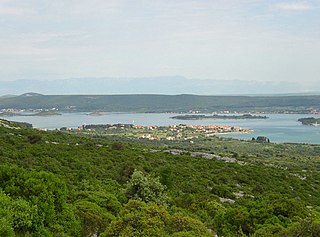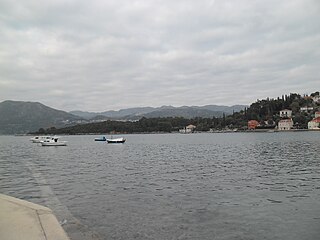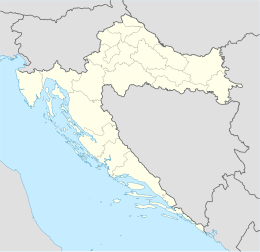
Dubrovnik, historically known as Ragusa, is a city in southern Dalmatia, Croatia, by the Adriatic Sea. It is one of the most prominent tourist destinations in the Mediterranean, a seaport and the centre of the Dubrovnik-Neretva County. Its total population is 41,562. In 1979, the city of Dubrovnik was added to the UNESCO list of World Heritage Sites in recognition of its outstanding medieval architecture and fortified old town.

Mljet is the southernmost and easternmost of the larger Adriatic islands of the Dalmatia region of Croatia. The National Park includes the western part of the island, Veliko jezero, Malo jezero, Soline Bay and a sea belt 500 metres wide from the most prominent cape of Mljet covering an area of 54 km2. The central parts of the park are Veliko jezero with the Isle of St. Mary, Malo jezero and the villages of Goveđari, Polače, and Pomena.

Pašman is an Adriatic island off the coast of northern Dalmatia in Croatia with an area of 60.11 km2, located to the south of Zadar, surrounded by the islands of Ugljan to the northwest, Iž to the west, and Dugi Otok and Žut to the southwest. The island is inhabited by 2,845 people, according to the 2011 census.

Lastovo is an island municipality in the Dubrovnik-Neretva County in Croatia. The municipality consists of 46 islands with a total population of 792 people, of which 94,7% are ethnic Croats, and a land area of approximately 53 square kilometres (20 sq mi). The biggest island in the municipality is also named Lastovo, as is the largest town. The majority of the population lives on the 46 square kilometres (18 sq mi) island of Lastovo.

The Elaphiti Islands or the Elaphites is a small archipelago consisting of several islands stretching northwest of Dubrovnik, in the Adriatic Sea. The Elaphites have a total land area of around 30 square kilometres and a population of 850 inhabitants. The islands are covered with characteristic Mediterranean evergreen vegetation and attract large numbers of tourists during the summer tourist season due to their beaches and pristine scenery.

Koločep is one of the three inhabited Elaphiti Islands situated near the city of Dubrovnik with an area of 2.44 square kilometres. Koločep is the southernmost inhabited island in Croatia. According to the 2021 census, its population was 231. In the 2011 census, the population of the island was 163.

Šipan, nicknamed the Golden Island, is an island located in southern Croatia, more specifically in the Dubrovnik-Neretva County. It is located 17 km (11 mi) northwest of Dubrovnik, and is separated from the mainland coast by the Koločep Channel, which has an area of 16.22 km2 (6.3 sq mi). The island is 9.1 km (5.7 mi) in length, and up to 2.6 km (1.6 mi) in width. It is a part of the Elaphiti Islands, and is the largest island in the archipelago. The name of the archipelago comes from the Ancient Greek word for deer, which, according to Pliny the Elder, used to inhabit the Elaphiti Islands in large numbers. There is, however, no evidence of deer ever inhabiting the archipelago.

Cavtat is a village in the Dubrovnik-Neretva County of Croatia. It is on the Adriatic Sea coast 15 kilometres south of Dubrovnik and is the centre and the main settlement of Konavle municipality.

The islands of Ilovik and Sveti Petar are located in Croatia south of the island Lošinj (Lussino), separated by the Strait of Ilovik.

Sveti Andrija is an island in the Croatian part of the Adriatic Sea. It is part of the Elaphiti Islands archipelago, Dalmatia and is situated 6 nautical miles (11 km) from Dubrovnik, 3 nautical miles (6 km) from Koločep, 2 nautical miles (4 km) from Lopud and 4 nautical miles (7 km) from Šipan. The island is 475 metres long, and its maximal width is 130 metres, while its coastline is 1,130 m (3,710 ft) long. The total area of the island is 53,757 square metres, with a maximum height elevation of 57 m (187 ft) above sea level.

Nikola Božidarević (pronounced[bɔʒi-ˈdə:rɔvitɕˈ]; more commonly Nicholas of Ragusa, was a painter from Venetian Dalmatia at the turn of the Gothic in the Renaissance.

Daksa is a small uninhabited island in the Croatian part of the Adriatic Sea. It is situated near Dubrovnik in front of the Rijeka Dubrovačka ria. The area of the island is about 0.07 km2 (0.027 sq mi), the highest point is 24 m (79 ft) above sea level.
Šćedro is an island in the Adriatic Sea with an area of 8.36 km2, 2.7 kilometres (1.7 mi) off the south coast of the island of Hvar, Croatia, opposite the settlement of Zavala. The name comes from štedri, meaning charitable in old Slavonic, because the island offers two deep, well-protected coves. The Latin name of Šćedro was Tauris from which derived the Italian Tauricola or Torcola.

Our Lady of the Angel is a monastery near Orebić, a town on the Pelješac peninsula, in the Dubrovnik-Neretva County, Croatia.
Crkvina is an uninhabited islet in Croatia, part of the Elaphiti Islands archipelago off the coast of southern Dalmatia, near Dubrovnik. Its coastline is 1.5 km (0.93 mi) long.

Ruda is an uninhabited islet in Croatia, part of the Elaphiti Islands archipelago off the coast of southern Dalmatia, near Dubrovnik. It is located between the islands of Lopud and Šipan. Its area is 0.296 km2 and its coastline is 2.37 km long. The highest point on Ruda is 81 m high.

Tajan is an uninhabited islet in Croatia, part of the Elaphiti Islands archipelago off the coast of southern Dalmatia, near Dubrovnik. It is located near the island of Jakljan. Its area is 0.111 km2 and its coastline is 1.41 km long.
Jakljan is an uninhabited islet in Croatia, part of the Elaphiti Islands archipelago off the coast of southern Dalmatia. It is located northwest of Dubrovnik and west of the island of Šipan. Its area is 3.4 km2 and its coastline is 14.6 km long. A children's resort and recreational center is located on the island.










































